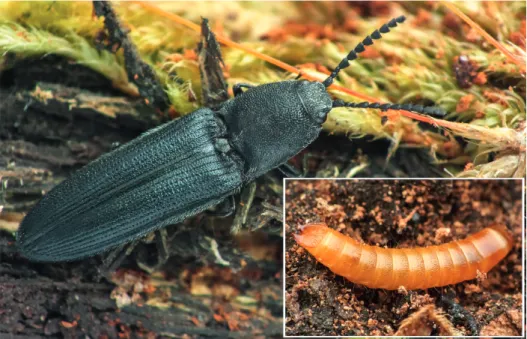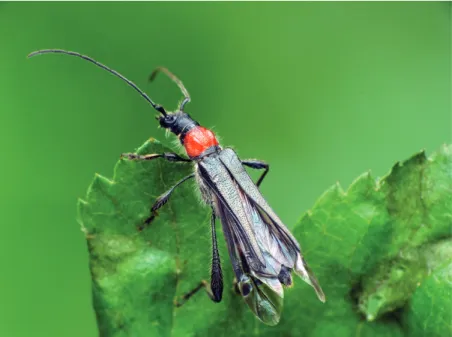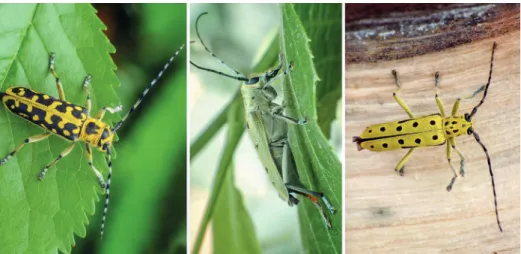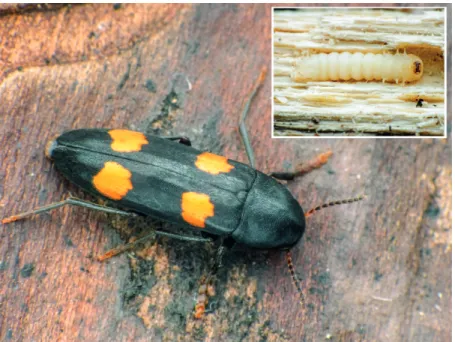Szaproxilofág bogáregyüttesek kutatása és monitorozása a Nyugat-Cserhát és a Naszály területén
Németh Tamás
Magyar Természettudományi Múzeum, Állattár, 1088 Budapest, Baross u. 13.
E-mail: nemeth.tamas@nhmus.hu
Összefoglalás – Hazánk idős erdőállományai természetvédelmi szempontból igen jelentős terüle- teink közé tartoznak. Az egyes nemzeti parkokhoz tartozó erdőkben számos ritka és érdekes bo- gárfaj fordul elő, melyek egy része Európa-szerte veszélyeztetett. Ezek sokszor törvényi szabályozás által védettek vagy fokozottan védettek. Ahhoz, hogy védelmük sikeresen megvalósítható legyen, állományaik pedig a jövőben is fennmaradhassanak, fontos megismernünk életmódjukat, pontos elterjedésüket és az életközösségeiket veszélyeztető tényezőket is. A Magyar Természettudományi Múzeum Bogárgyűjteményének szakemberei évek óta kutatják a hazai szaproxilofág bogárfaunát, megszerzett tudásukat és szakértelmüket felhasználva pedig rendszeresen vesznek részt a Du- na-Ipoly Nemzeti Park Igazgatóság természetvédelmi munkájában.
Kulcsszavak – biodiverzitás, Bogárgyűjtemény, Natura 2000, nemzeti park, szaproxilofág bogarak, védett fajok
BEVEZETÉS
A Duna-Ipoly Nemzeti Park Igazgatóság 2018-ban már sokadik alkalommal ke- reste meg múzeumunk Bogárgyűjteményének kutatóit természetvédelmi jellegű kéréssel – jelen esetben a Nyugat-Cserhát és a Naszály Natura 2000-es terület (HUDI20038) erdeihez kötődő bogárfauna felmérésével. A hazai nemzeti par- kok feladatai közé tartozik a területükön előforduló védett és természetvédelmi szempontból jelentős állatfajok, köztük a bogarak előfordulásának, állomány- nagyságának megismerése. További követelmény az egyes fajok védelme, az őket veszélyeztető tényezők feltárása és állományaik jövőbeli fennmaradásá- nak biztosítása. Ezek az elvárások nehezen kivitelezhetőek, ha korábban nem folyt alapos faunisztikai feltárás az egyes területeken. A Naszály bogárfaunáját már kutatták, nyolc évvel ezelőtt megjelent egy összefoglaló mű (Merkl 2010), melyben a Bogárgyűjtemény akkori munkatársai és számos amatőr rovarász is közreműködött. A Cserhát nyugati területeiről viszont szórványos adatok is alig álltak rendelkezésre.
112 Németh T.
A jelenlegi megbízás annyiban szűkítette a feladatot, hogy célja nem általá- nos bogárfaunisztikai felmérés volt, hanem a szaproxilofág, azaz a holt faanyag- hoz kötődő bogárfajok álltak a fókuszában. Hazánkban több tucat bogárcsalád több száz faja tekinthető szaproxilofágnak (Merkl 2016). Ezek sokszor külön- leges életmódú bogarak, melyek megtalálása speciális életmódjuk miatt nehéz feladat. Némelyikük csak bizonyos korú, elhalt rönkökben, hosszú évek alatt kialakult faodvakban vagy ritka gombákon fordul elő. Életmódjuk ismerete el- engedhetetlen ahhoz, hogy a nyomukra bukkanhassunk. Sokuk csak rövid ideig rajzik, azaz kicsi az esély a kifejlett bogárral találkozni. Ilyenkor a fejlődésük szín- helyén árulkodó maradványaik, az ágakon, rönkökön látható kirepülőnyílásaik vagy lárvajárataik árulkodhatnak jelenlétükről. Egy-egy fajra jellemző röplyuk azonosítása, apró, nehezen határozható lárváik határozása szakértelmet igényel.
ANYAG ÉS MÓDSZER
Mivel már számos hasonló jellegű felkérés futott be a gyűjteménybe, a kivitelezés nem volt különösebben bonyolult feladat. A Natura 2000-es területet műholdfel- vételen tanulmányozva kitűztük az egyes napok úticéljait, melyeket a nagyjából két tucat terepi nap alatt terveztük bejárni. Az időjárást és a terület adottságait figyelembe véve a terepi munkát április elején kezdtük meg, és május végéig foly- tattuk. Csapatunk 2–2 főre oszlott, mely nagyban segítette a terepi adatfelvételt.
Reggeli indulással átlagosan napi 2–3 területrészre jutottunk el, és egy-egy al- kalommal 10 kilométer körüli távot jártunk be. Alapvetően három módszerrel kerestük a szaproxilofág fajokat: holtfa bontása, rajzó imágók keresése és élet- nyomok detektálása.
A holtfa bontása értelemszerűen csak olyan erdőrészletekben kivitelezhe- tő, ahol nagy mennyiségű, különböző korú álló vagy földön fekvő elhalt faanyag található. Lényege, hogy a rönköket, faodvakat átvizsgálva, azokat kissé szét- szedve kutatunk bogarak után. A módszert óvatosan kell alkalmazni, mivel a túl- zott beavatkozás az élőhelyek megsemmisülésével járhat, ami ellentétes a feladat céljaival. Ezzel a módszerrel sok, tavasszal még a fában, fejlődésének színhelyén tartózkodó bogárfaj található meg. A jellemzően csak május végétől július vé- géig aktív, Natura 2000-es jelölőfaj, a nagy hőscincér (Cerambyx cerdo) imágója áprilisban még egy karvastagságú tölgyágban rejtőzött, a nézsai Patkó-hegyen (1. ábra). A szintén Natura 2000-es jelölőfaj és fokozottan védett kék pattanó (Li- moniscus violaceus) rejtett faodvakban fejlődik. Lárvája viszonylag jól azonosít- ható, a terület 12 pontjáról került elő (2. ábra).
Rajzó imágókat csak az első, melegebb tavaszi napoktól találtunk. Nyílt te- rületeken, például gyepeken, homokpusztákon jóval korábban előbújnak a bo- garak, ám amint az erdő lombosodni kezd, kissé lassabb ütemben az erdei fajok
1. ábra. Nagy hőscincér (Cerambyx cerdo) (fotó: Németh T.) Fig. 1. Great Capricorn beetle (Cerambyx cerdo) (photo: T. Németh)
2. ábra. Kék pattanó (Limoniscus violaceus) és lárvája (fotó: Németh T.) Fig. 2. Violet click beetle and its larva (Limoniscus violaceus) (photo: T. Németh)
114 Németh T.
3. ábra. Frakkos cincér (Callimoxys gracilis) (fotó: Németh T.) Fig. 3. Longhorn beetle (Callimoxys gracilis) (photo: T. Németh)
4. ábra. Kis szarvasbogár (Dorcus parallelipipedus) (fotó: Németh T.) Fig. 4. Lesser stag beetle (Dorcus parallelipipedus) (photo: T. Németh)
5. ábra. Bükkfa-díszbogár (Dicerca berolinensis) és kirepülőnyílása (fotó: Németh T.) Fig. 5. Jewel beetle Dicerca berolinensis and its exit hole (photo: T. Németh)
6. ábra. Létracincér (Saperda scalaris), nyolcpontos cincér (Saperda octopunctata) és díszes nyárfa- cincér (Saperda perforata) (fotó: Németh T.)
Fig. 6. Longhorn beetles Saperda scalaris, Saperda octopunctata and Saperda perforata (photo: T. Németh)
116 Németh T.
7. ábra. Déli komorka (Dircaea australis) és lárvája (fotó: Németh T.) Fig. 7. The darkling Dircaea australis and its larva (photo: T. Németh)
8. ábra. Recés álcsuklyásszú (Endecatomus reticulatus) (fotó: Németh T.) Fig. 8. Endecatomus reticulatus (photo: T. Németh)
is előjönnek. Májusban viszont már virágzó cserjéken, farakásokon és erdei utak mentén számos bogarat lehet találni. A frakkos cincér (Callimoxys gracilis) (3. áb- ra) rövid ideig rajzik, a Naszályon és a Cserhátban viszonylag gyakorinak mond- ható. A galagonya és a tatárjuhar virágzásával egy időben többfelé találkoztunk vele. A kis szarvasbogár (Dorcus parallelipipedus) imágó alakban telel (4. ábra), így mind fabontásos módszerrel, mind pedig aktív időszakában gyakran láthat- juk öreg tuskókon és rönkök alatt.
Az egyes fajok életnyomainak felkutatása egyszerre könnyű és nehéz fel- adat. Könnyű, mert ha tudjuk, mit keressünk – például a bükkfa-díszbogár (Di- cerca berolinensis) kirepülőnyílását kéregtelen gyertyánon – akkor célzottan ku- tathatunk utána (5. ábra). Nehéz pedig azért, mert alaposan kell ismerni a szóba jöhető fajokat és azok életmódját.
A Saperda genusz fajai színpompás cincérfajok. Minden fajuk a rá jellem- ző tápnövényekben fejlődik, imágóik májustól aktívak, és főként a lombkoro- naszintben mozognak. Habár látványos bogarak, nehéz őket megtalálni, ezért célravezetőbb az adott tápnövényen az előző évi kirepülőnyílásaikat keresni. Cse- resznyében a létracincér (Saperda scalaris), hársfajokban a nyolcpontos cincér (Saperda octopunctata), míg rezgőnyárban a díszes nyárfacincér (Saperda perfo- rata) fejlődik (6. ábra).
A felmérés során a védett fajokra, azokon belül is főleg a Natura 2000-es je- lölőfajokra koncentráltunk. Ám az egyes fajok védettsége és pénzben kifejezett értéke nem feltétlenül áll arányban a ritkaságukkal. A jól ismert, feltűnő és Európa legtöbb országában védelem alatt álló, emblematikus fajok mellett számos, igazi ritkaságnak számító, és bogarász szívet melengető bogárfajjal is volt szerencsénk találkozni. Egyik ilyen a déli komorka (Dircaea australis), mely igazi ritkaság ha- zánkban, ám úgy fest, a vizsgált területen azért nem lehetetlen ráakadni (7. ábra).
Ez a csinos megjelenésű bogár gombákkal átjárt vastagabb, több éve elhalt farön- kökben fejlődik. A recés álcsuklyásszúból (Endecatomus reticulatus) csupán 1–2 példány volt ismert Magyarországról. Egy hatalmas pisztricgomba termőtestén tucatnyi egyedet találtunk ebből az Európa-szerte ritka bogárfajból (8. ábra).
EREDMÉNYEK
A felsorolt módszerekkel a Nyugat-Cserhát és Naszály Natura 2000 területen 36 család összesen 211 szaproxilofág bogárfaját azonosítottuk. Közülük 32 faj védett, 1 fokozottan védett és 5 Natura 2000 jelölőfaj (9. ábra). Mivel a terepmunkára ösz- szesen két hónap állt rendelkezésünkre, ez az eredmény kifejezetten jónak mond- ható. Az elvégzett feladatról május végén jelentést adtunk le, valamint elterjedési térképeket készítettünk a felvett bogarak WGS-koordinátáival. Az érdekesebb fa- jokból pedig néhány példánnyal gyarapítottuk a Bogárgyűjtemény anyagát.
118 Németh T.
ÖSSZEGZÉS
A bejárt területek nagy része nem kedvez a holtfában élő bogárfajoknak. Sok a fiatal, gazdasági szempontból kezelt erdőrész, valamint a túltartott vadállomány is jelentősen károsítja a bogárfaunát. A vaddisznók kiforgatják a tuskókat a ta- lajból, feldúlva ezzel a bogarak élőhelyét. A fiatal erdőkben szinte alig található holtfa, a kiszáradt, kidőlt fákat pedig az idősebb erdőrészletekből is eltávolítják.
A gazdasági célú erdőkezelés sajnos nagyban hozzájárul az erdők biodiverzitá- sának csökkenéséhez. Az egymásra épülő elemek megfogyatkozása hatással van az egész rendszer, azaz az ökoszisztéma egészére. Tehát ha egy erdőben kevés a holtfa, akkor kevés a bennük fejlődő bogár is. Emiatt kevesebb rovarfogyasztó madár és emlős él a területen, melynek következményeként a velük táplálkozó ra- gadozók száma is csökken. Ez a folyamat hazánkban évtizedek óta tart, megféke- zésére csak az utóbbi időben történnek erőfeszítések. Az egyes, főként az Európai Unió által finanszírozott pályázatok révén van esély arra, hogy a nemzeti parki igazgatóságok a működési területükre eső erdőket természetvédelmi szempon- tok alapján kezeljék. A mesterséges holtfaképzés az egyik ilyen módszer. Ennek során különféle módszerekkel – élőfa-sebzés, döntés, kérgezés – elérhető, hogy az elhalt faanyag mennyisége növekedjen az egyes területeken, élőhelyet teremt- ve ezáltal sok szaproxilofág fajnak.
* * *
9. ábra. A Nyugat-Cserhát és a Naszály Natura 2000-es területen felvett mintavételi pontok Fig. 9. Sampling points within the Western Cserhát and Mt. Naszály Natura 2000 site
Investigation and monitoring of saproxylic beetles in the Western Cserhát and the Naszály
Tamás Németh
Zoological Collection of the Hungarian Natural History Museum, 1088 Budapest, Baross u. 13.
E-mail: nemeth.tamas@nhmus.hu
Abstract – Old forests are amongst the most significant habitats in terms of nature conservation.
The forests belonging to our national parks are home to several rare and interesting beetle species, the status of which is vulnerable across Europe and most of these are protected or strictly protected in Hungary. For their effective conservation, however, we need to know the exact distribution of their remaining populations, their life cycles and the relevant threat factors. The staff of the Hun- garian Natural History Museum has been investigating the saproxylic beetle fauna of Hungary for several years and their expertise is often called for by the Danube-Ipoly National Park Directorate for nature conservation purposes.
Keywords – biodiversity, Coleoptera Collection, national park, Natura 2000, protected species, saproxylic beetles
INTRODUCTION
In 2018, the Danube-Ipoly National Park Directorate commissioned the staff of the Coleoptera Collection of the Natural History Museum to carry out the survey of the beetle fauna of the forests of the Western Cserhát and Mt Naszály Natura 2000 site (HUDI20038). Such an undertaking for nature conservation purposes has not been without precedent. Among many other tasks, the Hun- garian national park directorates are entrusted with the investigation of bio- diversity assets such as valuable species and keeping tab on their population sizes. Another one of their responsibilities is the protection of these assets, the assessment of risk factors and the sustainable management of their population.
These tasks cannot be carried out efficiently without previous faunistic surveys of the relevant sites. The beetle fauna of Mt. Naszály is already well-explored and a comprehensive work was published a few years ago (Merkl 2010) with contributions from the staff members of the Coleoptera Collection and several amateur coleopterans. However, data from the western parts of the Cserhát used to be few and far between.
The present contract with the national park directorate focused only on the saproxylic beetles, instead of a general fauna survey. We were commissioned to ex- plore only those species whose life cycle is connected to dead wood. In Hungary,
120 Németh T.
there are several hundred species belonging to dozens of families that can be re- garded as saproxylic (Merkl 2016). These beetles often have very specialized life histories and finding them may present a difficult task. Certain species can only be found in dead logs of a certain size or age, others in tree cavities that form over long time periods, while others frequent the fruiting bodies of rare fungi. With- out thorough knowledge of these life histories, it is practically impossible to find these creatures. Some of these beetles only swarm for a brief time period making it difficult to come across adult specimens. Mostly, it is only their remains or their life signs that indicate their whereabouts: exit holes on branches and trunks or the burrow tunnels the larvae create inside. To identify the species by these life signs or by the larvae requires specific expertise.
MATERIAL AND METHODS
Such a commission was not unprecedented in the history of the collections and thus carrying out the survey was not too difficult. Based on satellite imagery of the Natura 2000 site, we picked the locations we had to visit one by one during approximately two dozen field days. Considering the prevailing weather and the attributes of the area, we started the field season at the beginning of April and finished at the end of May. The four of us worked in pairs which greatly sped up data collection. Stating off early in the morning, we could cover two or three sites a day, walking about 10 kilometres on each occasion. We applied three methods for finding the saproxylic beetles: breaking open deadwood, looking for swarm- ing adults and detecting life signs.
Breaking up dead wood is feasible only in those parts of a forest where there is a large amount of dead wood of different ages (either standing or fallen). Es- sentially, we crumble up the pieces of dead wood, inspecting the cavities and the insides to find the beetles. This method must be applied with caution as if done too intensively, this activity can destroy valuable habitat – which we aim to con- serve for these beetles. By this method, several species of beetles can be found within the trunk where they develop in spring before they emerge. The great Cap- ricorn beetle (Cerambyx cerdo), a species listed in the annexes of the Natura 2000 Habitat Directive is only active from May untill the end of July. This adult beetle was still hiding in an arm-strong bough of an oak tree in April, on Mt. Patkó of Nézsa (Fig. 1). Another Natura 2000 species, the violet click-beetle (Limoniscus violaceus) develops in well-concealed tree cavities. The larva is relatively easy to identify and we recorded it at 12 different locations within the site (Fig. 2).
From the first warm days of spring, we also encountered swarming adult beetles. In open areas, such as sand steppes and other grasslands, species typical- ly emerge earlier, but as soon as the trees break into leaf, forest-dwelling species
also start to show themselves gradually. In May, many beetles can be observed on flowering bushes, timber deposits and along forest roads. The swarming of the longhorn beetle Callimoxys gracilis (Fig. 3) only lasts for a brief time period, but it is relatively common on Mt. Naszály and in the Cserhát. We observed it in many locations synchronously with the flowering of the hawthorn and the Ta- tarian maple. The lesser stag beetle (Dorcus parallelipipedus) overwinters in adult form (Fig. 4) and thus it can be detected by breaking open trunks or observing it later on in the season on old stumps and underneath logs.
Finding signs of these species is easy on the one hand while difficult on the other. Easy, because for certain species we know what to look for – such as the char- acteristic exit holes of the jewel beetle Dicerca berolinensis on barkless logs of horn- beam – thus allowing us to search with a very narrow focus (Fig. 5). However, it takes thorough knowledge of the life cycles of many species to design a survey well.
The species belonging to the genus Saperda are colourful longhorn beetles.
Each species develops in their own host plant, and the adults that become active in May mostly move around in the canopy. Even though these are spectacular beetles, it is quite difficult to observe the adults. They are more effectively found by their exit holes on their host plants. Saperda scalaris for example develops in cherry trees, Saperda octopunctata in linden, while Saperda perforata develops in common aspen (Fig. 6).
Our survey focused on protected beetle species with a special highlight on species listed by the Natura 2000 legislation. However, the level of protection or the theoretical value of a species is not necessarily in line with its scarcity. Apart from the well-known, iconic beetles that are very popular and are protected in most member states on account of their eye-catching appearance, we came across several rare assets that would make the heart of any coleopterologist jump. One of these was a real gem for Hungary, Dircaea australis that turned out to be an inhabitant of the study area (Fig. 7). This attractive beetle develops in old dead wood that is already largely consumed by fungi. The previous record for Ende- catomus reticulatus only numbered two specimens from the entire territory of Hungary. Here, we found at least a dozen adults on the fruiting body of a huge Dryad’s saddle polypore (Fig. 8).
RESULTS
By applying the above mentioned methods, we recorded altogether 211 saprox- ylic beetle species belonging to 36 families within the West Cserhát and Naszály Natura 2000 site. Among these, 32 species are protected, one is strictly protected and five are listed by the Natura 2000 legislation (Fig. 9). As we were constrained by a two-month-long field season, these results can be regarded as positive.
122 Németh T.
SUMMARY
Most of the sampled area provides unfavourable conditions for deadwood-dwell- ing beetles. There are many economic stands of young ages and overexploitation by big game species also causes damage to saproxylic populations. Wild boars often uproot stumps while foraging thus destroying potential microhabitat. The young stands contain hardly any dead wood and dry trees, fallen logs and trunks are routinely extracted even from older forest stands. Economically minded for- est management greatly reduces biodiversity of forest habitats. The loss or disap- pearance of any element from such an intricate, hierarchical network as a forest, essentially upsets the balance of the entire ecosystem. In a forest with little or no dead wood, there can be no saproxylic communities. This in turn makes the hab- itat an inadequate home for insectivorous birds and mammals, rippling across the food chain until the top predator levels. Such a process has been under way in Hungary for decades, but recently there have been some efforts to slow it down.
Grants, such as those from the European Union conservation funds allow na- tional park directorates to manage the forests within their territories in a nature conservation-oriented way. Recreating depleted dead wood stocks by means of de-barking certain tree specimens is such a specific management action by which various microhabitats can be created in selected plots, making space for sapro- xylic beetles.
*
IRODALOM – REFERENCES
Merkl O. 2010: A Naszály bogárfaunája (Coleoptera). (Beetles (Coleoptera) of Mt Naszály (Hun- gary).) – In: Pintér B. & Tímár G. (eds): A Naszály természetrajza. (A natural history of Mt Naszály, Hungary.) Rosalia (A Duna-Ipoly Nemzeti Park Igazgatóság tanulmánykötetei, 5.) Duna-Ipoly Nemzeti Park Igazgatóság, Budapest, pp. 533–639.
Merkl O. 2016: A szaproxilofág bogarak (Coleoptera) szerepe a holtfa lebontásában. (The role of saproxylic beetles (Coleoptera) in the decomposition process of deadwood.) – In: Korda M. (ed.): Az erdőgazdálkodás hatása az erdők biológiai sokféleségére. [The role of forestry ma- nagement to the biodiversity of the forests]. Duna-Ipoly Nemzeti Park Igazgatóság, Budapest, pp. 129–154.




